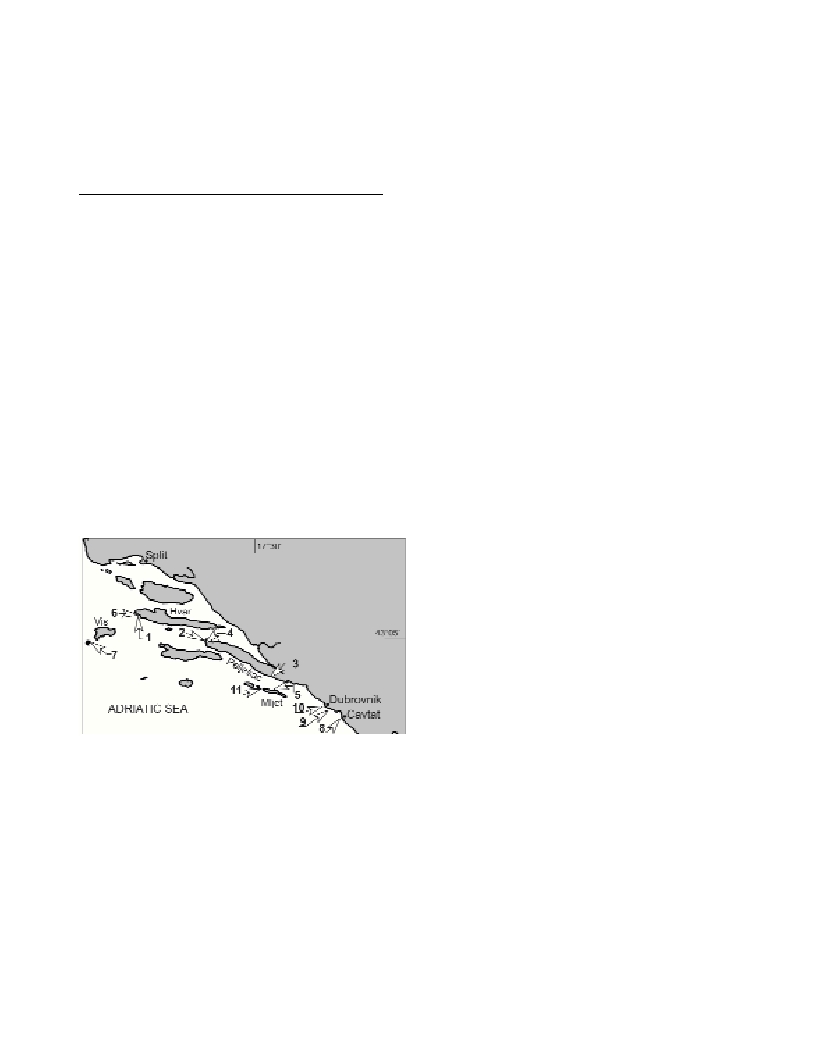THE SPREAD OF THE INVASIVE VARIETY OF CAULERPA RACEMOSA IN THE ADRIATIC SEA
A. Žuljevic
1*
, B. Antolic
1
, M. Despalatovic
1
, V. Onofri
2
1
Institute of Oceanography and Fisheries, Split, Croatia - * zuljevic@izor.hr
2
Institute of Oceanography and Fisheries, Dubrovnik, Croatia
Abstract
By the end of 2003, Caulerpa racemosahad been discovered at 11 locations along the Croatian coast of the Adriatic Sea. Here we discuss
the possible mechanisms and vectors of its long distance dispersal.
Key-words: Caulerpa racemosa, Adriatic Sea, dissemination
Rapp. Comm. int. Mer Médit., 37,2004
466
Introduction
The first record of the invasive variety of Caulerpa racemosa
(Forsskĺl) J. Agardh (Caulerpales, Chlorophyta) in the Mediterranean
Sea was in 1990 in Tripoli (Libya). In the next 10 years it was found
also in Tunis, Egypt, Cyprus, Turkey, Greece, Malta, Italy, France,
Spain and Croatia (1). The vector of its introduction to the
Mediterranean Sea as well as its phylogenetic relations are still
unknown (2). Moreover there is still doubt about the vectors of its
long distance dispersal.
The first report in the Adriatic Sea was in 2000 on the Pakleni
archipelago (3). Here we present new data about its spread along the
Croatian part of the Adriatic Sea, and discuss a possible mechanism
of its long distance dispersal.
Observation and Discussion
By the end of 2003, 11 distant stations of Caulerpa racemosahad
been discovered (Fig. 1). The algae proliferates on rocky, sandy and
muddy bottoms, in photophilic and sciaphilic communities, as well as
in meadows of Posidonia oceanica (L.) Delile and Cymodocea
nodosa(Ucria) Ascherson seagrass, and on sessile animals such as
sponges. It grows from 0.5 to 50 m deep, with the densest colonies
forming between depths of 2 and 30 m. The most dense colony was
recorded on Pakleni Island at 7 m deep where the canopy contained
2600 m m
-2
of total stolon length and nearly 27 000 fronds m
-2
(3).
Several mechanisms could be involved in the long distance
dispersal of the alga throughout Adriatic Sea.
Anchoring.As is the case with C. taxifolia, it is likely that
C.racemosacould be transported in boat anchor lockers. However,
most of the infested stations in the Adriatic Sea are not suitable or
common mooring places.
Fishing nets.The infestation in Mirce village was probably
introduced by fishing nets from the significantly larger colony in
CesminovaCove. The alga was observed in a small fishing harbour
where fishermen clean their nets.
Sexual reproduction.There is no strong evidence that sexual
reproduction in the Mediterranean Sea is successful. The only
observation of the formation of both types of gametes was in Greece
(4), but with a low percentage of gamete conjugation and formation of
planozygotes. Moreover, the authors suspect that the observed zygotes
could have been an artefact of incomplete cleavage during
gametogenesis, which at the time of observation looked like
planozygotes.
Fragmentation.As with fragments of C. taxifolia, fragments of
C.racemosado not ?oat. Due to its spherical ramuli, C. racemosa
fragments sink relatively slowly, and may be more easily transported
by currents. However, thalli of C. racemosaconsist predominantly of
the creeping stolon. In C. taxifoliathe predominant part are fronds.
Becouse of that, in the colonies of C. taxifoliathere are usually
numerous frond fragments, while in C. racemosacolonies fragments
are rare.
Epiphytes.Caulerpa racemosagrows on other macro algae such as
Cystoseiraand Sargassumspecies. Detached Cystoseiraor
Sargassumthalli could ?oat for several days and disperse attached
C.racemosa.
Propagules.Spherical ramuli can separate from the fronds and act
as propagules (5) that could be carried by currents and waves. It is not
known how far the propagule could be carried.
Ballast water.In order for ballast water to be a vector of
C.racemosaspread, there must be a ?oating phase of its lifecycle
(fragments, propagule or zygotes). Although it is unknown if
C.racemosahas this ?oating phase, ballast water is usually released
offshore far away from the recorded colonies in the Adriatic Sea.
Currents.Most of the C. racemosarecords in the Adriatic Sea
correspond with the ?ow of the cyclonic Adriatic Current. The closest
colony from where the algae could have originated and been driven by
the cyclonic Adriatic Current was found in the Ionian Sea (Zakynthos
Island) in 1993 (6). Unfortunately there is no information about
C.racemosaalong the Albanian coast which could support the theory
of dispersal by currents.
Conclusion
The geographic distribution of most of the C. racemosacolonies in
the Adriatic Sea suggests that the cyclonic Adriatic Current could be
the basic vector of C. racemosalong distance dispersal. The portion
of the thallus that ?oats (fragments, propagules, zygotes or epiphytic
transportation) remains unknown.
References
1-Verlaque, M., Boudouresque, C.F., Meinesz, A., Gravez, V. 2000. The
Caulerpa racemosacomplex (Caulerpales, Ulvophyceae) in the
Mediterranean Sea. Bot. Mar., 43: 49–68.
2-Durand, C., Manuel, M., Boudouresque, C.F., Meinesz, A., Verlaque,
M., Le Parco, Y. 2002. Molecular data suggest a hybrid origin for the
invasive Caulerpa racemosa (Caulerpales, Chlorophyta) in the
Mediterranean Sea. J. Evolution. Biol., 15: 122-133.
3-Žuljevic A., Antolic B., Onofri V. 2003. First record of Caulerpa
racemosa(Caulerpales, Chlorophyta) in the Adriatic Sea. J. Mar. Biol.
Assoc., 83: 711-712.
4-Panayotidis P., Žuljevic A.2001. Sexual reproduction of the invasive
green alga Caulerpa racemosavar. occidentalisin the Mediterranean Sea.
Oceanol. Acta, 24 (2): 199-203.
5-Renoncourt, L., Meinesz, A. 2002. Formation of propagules on an
invasive strain of Caulerpa racemosa (Chlorophyta) in the Mediterranean
Sea. Phycologia, 41: 533-535.
6-Panayotidis P., Montesando B. 1994. Caulerpa racemosa
(Chlorophyta) on the Greek Coasts. Cryptogam. Algol., 15: 159-161.
Fig. 1. Stations of Caulerpa racemosanumbered by historical record: 1)
Pakleni Islands, 2) Cesminova Cove, 3) Marculeti Bay, 4) Mirca, 5) Cape
Pusti, 6) Vela Garška Cove, 7) Mezuporat Cove, 8) Cavtat, 9) Dubrovnik
– Cape Osti, 10) Dubrovnik, 11) Goli Islet.

